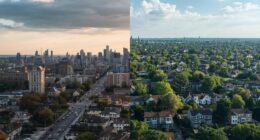How Location Impacts Your Lifestyle More Than You Think
The Hidden Power of Where You Live
Where you live determines far more than just your address — it shapes your mindset, habits, health, finances, and even happiness.
Your location impacts your lifestyle in ways that most people underestimate.
From how you spend money to how you socialize, from your career opportunities to your mental well-being — your surroundings influence nearly every aspect of your daily life.
In this article, we’ll explore how your location affects your financial freedom, lifestyle choices, relationships, and quality of life, and how you can choose a place that supports your goals and long-term happiness.
Why Location Is the Foundation of Lifestyle Design
Your environment acts as both a mirror and a mold — reflecting who you are while shaping who you become.
The right location can enhance motivation, creativity, and wealth-building potential, while the wrong one can limit growth and drain resources.
Core Areas Affected by Location
-
Financial habits and cost of living
-
Mental and physical health
-
Work-life balance
-
Social interactions and networking opportunities
-
Access to nature, culture, and education
Your zip code can quietly influence your mindset, opportunities, and even lifespan — that’s how powerful location really is.
Table – How Location Affects Key Lifestyle Factors
| Category | Urban Living (City Buzz) | Suburban / Rural Living (Calm & Space) |
|---|---|---|
| Cost of Living | High rent, higher utilities | More affordable housing and daily costs |
| Career Opportunities | More networking, faster growth | Remote or local business opportunities |
| Work-Life Balance | Fast-paced, time-sensitive | Relaxed pace, family-oriented |
| Social Life | Cultural events, nightlife | Community gatherings, deeper connections |
| Health Impact | More stress, pollution | Better air quality, nature access |
| Real Estate Value | High short-term gains | Stable long-term appreciation |
| Commute Time | Shorter distance but stressful | Longer distance but peaceful drive |
| Ideal For | Young professionals, entrepreneurs | Families, retirees, digital workers |
Choosing the right balance between city buzz and suburban calm directly shapes your daily happiness, budget, and personal growth.
Step 1 – Understand the Financial Geography of Lifestyle
Location and finances are inseparable.
Your address determines your taxes, rent, transportation costs, and even food prices.
How Location Affects Your Finances
-
Living in cities offers higher income potential but higher expenses.
-
Suburban areas often mean lower costs but fewer high-paying jobs.
-
States and countries differ in tax structures that affect take-home pay.
-
Access to public transportation vs. car dependency can add or save thousands per year.
By choosing your location strategically, you can achieve financial comfort without sacrificing lifestyle quality.
Learn more about aligning money with lifestyle goals in our article — How to Stay Financially Confident in Uncertain Times.
Step 2 – How Location Influences Health and Happiness
The air you breathe, the noise you hear, and the pace of life you live all affect your physical and mental well-being.
Environmental Wellness Factors
-
Green spaces: Access to parks reduces stress and increases longevity.
-
Noise pollution: Constant urban noise raises cortisol (stress hormone) levels.
-
Commute stress: Long commutes decrease happiness and productivity.
-
Weather: Climate impacts energy, mood, and physical activity.
Studies show people living near nature or coastal areas report higher satisfaction and lower anxiety than those in dense urban centers.
Step 3 – Location and Career Opportunities
Your location directly affects how you work and how much you can earn.
Urban Advantage
-
Closer to large companies and networking events
-
Easier career changes and collaboration opportunities
-
Higher competition but faster career growth
Suburban & Remote Advantage
-
Remote work flexibility
-
Lower daily stress
-
Better home-office environments
Today, digital nomads and remote professionals are proving that income doesn’t have to depend on location — only your discipline does.
Step 4 – Social Connections and Community
Location dictates who you meet and how you connect.
Urban environments offer diversity and exposure to global ideas, while smaller towns often provide community warmth and trust.
Building the Right Network
-
In cities, attend professional meetups and seminars.
-
In suburbs, engage in community clubs and volunteer work.
-
Join online communities to expand beyond geography.
Social health contributes heavily to happiness — and location defines your access to meaningful relationships.
Step 5 – Real Estate, Wealth, and Long-Term Stability
Your real estate decisions are not just financial — they are lifestyle decisions that last decades.
Urban Investment
-
High demand, faster returns, but costlier entry
-
Better for short-term rental or Airbnb markets
Suburban Investment
-
Lower purchase cost, larger space
-
Better for long-term family or rental stability
Real estate is a wealth-building tool when paired with a lifestyle that supports your income and comfort levels.
Check Zillow’s Real Estate Market Trends to compare property values and long-term investment data for different cities.
Step 6 – Education and Family Considerations
If you have or plan to have a family, education quality is often the deciding factor in choosing where to live.
Urban Education Pros
-
More diverse programs and extracurriculars
-
Access to international schools or universities
Suburban Education Pros
-
Smaller class sizes, safer environments
-
Strong sense of school community
Educational access defines both your children’s and your family’s future financial potential.
Step 7 – Safety, Crime, and Peace of Mind
Safety plays a key role in both daily comfort and mental stability.
Even if urban life offers excitement, constant alertness can cause emotional fatigue.
General Safety Observations
-
Suburban areas often report lower crime rates.
-
Gated or planned communities enhance security.
-
Urban condos with smart systems provide protection at higher costs.
Peace of mind is part of wealth — safety equals quality of life.
Step 8 – Transportation and Daily Commute Impact
Your daily commute affects time, stress, and even your lifespan.
City Transport Pros
-
Reliable public transport (metro, bus, rail).
-
Walkable neighborhoods reduce car dependence.
-
Traffic and noise can raise daily tension.
Suburban Transport Pros
-
Driving freedom and personal control.
-
Longer drives but scenic routes and lower stress.
The average person spends over 8 years commuting in a lifetime — your location determines whether that time feels wasted or peaceful.
Step 9 – Environmental and Sustainability Factors
Eco-friendly living is becoming a defining lifestyle trend.
Your location influences how sustainable your daily habits can be.
Sustainable Living Insights
-
Urban residents often use less fuel due to smaller homes and public transport.
-
Suburban areas offer potential for solar panels, gardens, and green construction.
-
Access to recycling, farmers’ markets, and clean energy sources varies widely.
Choosing eco-conscious locations helps you align wealth, wellness, and environmental responsibility.
Step 10 – Cultural Access and Lifestyle Enjoyment
Your environment influences how you spend your free time and what experiences shape your identity.
Urban Experiences
-
Museums, live music, restaurants, nightlife.
-
Faster access to innovation and entertainment.
Suburban Experiences
-
Outdoor recreation, local festivals, community gatherings.
-
More family-friendly, wellness-focused events.
Your surroundings either stimulate creativity and exploration — or peace and restoration. The right balance depends on your personality and goals.
Step 11 – How Location Shapes Your Financial Mindset
Location doesn’t just affect your expenses — it affects how you think about money.
In large cities, status pressure often leads to higher spending, while smaller communities encourage saving and value-based living.
Mindset Shifts by Location
-
City: “Earn more, spend more” mentality.
-
Suburbs: “Save more, enjoy simply.”
-
Remote/Rural: “Live freely, work strategically.”
Knowing your emotional triggers helps you design a wealth-aligned lifestyle that matches your values.
Step 12 – Finding the Balance: Hybrid Living
Many modern professionals now blend both lifestyles — living near cities for work and spending weekends in calmer suburbs or rural getaways.
Hybrid Living Tips
-
Choose a suburb within 30–45 minutes of your main city.
-
Invest in a second home or co-living space.
-
Use flexible remote work schedules to mix productivity and peace.
Hybrid living allows you to enjoy urban opportunity with suburban serenity — the best of both worlds.
Step 13 – How Relocation Can Redefine Your Life Goals
Sometimes, moving to a new location completely redefines your identity.
A new environment can reset your routines, social circles, and mindset.
Relocation Benefits
-
Fresh start for habits and goals.
-
Lower stress, higher focus.
-
New networks and opportunities.
-
Improved financial planning and spending habits.
Relocating strategically can become the catalyst for a better lifestyle and wealth journey.
Step 14 – Technology and the Rise of Digital Location Freedom
With the rise of digital nomadism, location independence is no longer a dream.
Technology allows people to earn globally while living anywhere.
Digital Lifestyle Advantages
-
Live in low-cost countries with high income.
-
Access to online education and jobs.
-
Balance work, travel, and family life.
Freedom of location equals freedom of time and financial flexibility — the ultimate lifestyle advantage.
Conclusion: Choose Location Intentionally — Live Abundantly
Your location impacts your lifestyle more than you think — influencing your health, wealth, and happiness daily.
By choosing your environment consciously, you can design a life that reflects your values and supports your long-term vision.
Whether you crave the city’s energy or the suburbs’ peace, what matters most is alignment — between your financial goals, lifestyle desires, and emotional well-being.
Remember: where you live shapes how you live.
Choose wisely, and your location will become the foundation of your dream lifestyle and financial freedom.








